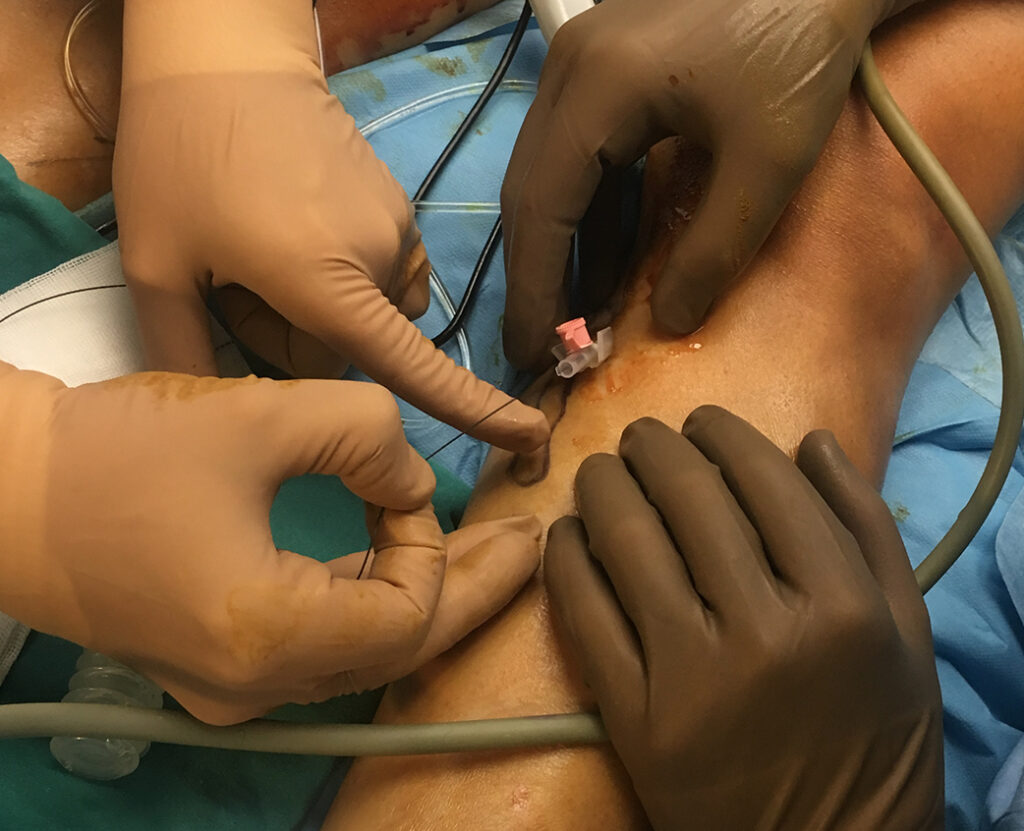DO YOU KNOW THAT MODERN TREATMENT METHODS IN VARICOSE VEIN TREATMENT
HAVE ACHIEVED A SUCCESS RATE OF 86% OVER THE PAST 5 YEARS?
Endovenous Trunkal Ablation (E.V.T.A.)
Among the latest innovations in the treatment of varicose veins is Endovenous Trunkal Ablation. Today, the classical varicose vein surgery method is replaced by this new procedure with a five-year success rate of 86%.
Most often, it is done using radiofrequency or laser energy. Heat is applied into the patient’s vein through a catheter that can be defined as a “thin plastic tube”. No incision is made that requires stitches. The heat directed to the vein affects the collagen substance in the wall, the vessel contracts and closes on itself. This vein, which is out of circuit, is completely absorbed and destroyed by the body within 8-12 months.

Which Veins Can Be Treated With Endovenous Trunkal Ablation (E.V.T.A.) ?
Varicose veins that we see with the bare eye on the skin (spider and reticular veins and large varicosities wider than 4 mm) can be treated with Visual Foam Sclerotherapy and Ambulatory Phlebectomy methods. The Great Saphenous vein (VSM/GSV) on the inner side of the leg, the Small Saphenous vein (VSP/SSV) in our calf and the connecting veins are located deeper than the skin and are not visible to the eye. When the unidirectional valves in these veins are disrupted and venous insufficiency develops, the inner pressure of the vein increases and leads to the expansion of the vessel diameter. E.V.TA. technique is most commonly applied to these vessels and their side branches, with leaking valves at moderate/severe levels.
How to Apply Endovenous Trunkal Ablation (E.V.T.A.)?
E.V.TA. is performed in outpatient clinic conditions or in the operating room. One of the biggest advantages of the method is that it does not require general or major regional anesthesia, but can be performed under local (tumescent) anesthesia. Under Doppler ultrasound imaging, a special catheter is inserted into the veins to be treated and heat is given to the inner wall of the vessel and the vessel is closed. The procedure takes an average of 9-17 minutes for each vein, and at the end of the procedure, pressure socks are put on the leg. Following E.V.TA. no serious discoloration or sensitivity on the skin occurs; patient walks immediately and can return to normal life the next day. Complaints before the procedure disappear quickly. The patient is not recommended to rest.
The safety of radiofrequency and laser technologies in the treatment of E.V.T.A. has been proven in large patient groups and in 10 year follow-up studies.
Similarly, by placing a catheter inside the vein that injects a glue is a new and promising technology. Long-term results of the glue method in large patient groups and long-term results have not yet been obtained.
Today, the classical varicose vein surgery method is replaced by this new procedure with a five-year success rate of 86%.
What Are the Rare Side Effects of Endovenous Trunkal Ablation (E.V.T.A.)?
- Numbness: It may be felt below the knee.
- Pain: The leg pain that can be felt on the day of the intervention can be relieved with a single dose of a simple painkiller.
- Pulling sensation: It can be felt in the thighs and legs. It disappears with the absorption of the closed vein by the body.
- Tenderness and redness: Disappears within 3-7 days.
- Deep venous thrombosis: Very This complication can be eliminated with the help of a detailed Doppler imaging during the insertion of the catheter into the vein. In addition, wearing pressure socks after the procedure and starting to walk quickly prevents this problem .
- Skin infection: It can only occur if the intervention is performed under nonsterile conditions.
- Bruising on the skin: It is usually very mild and disappears in a few weeks with the use of some gels.
- Failure of the procedure: It can be seen as a result of the inability to place the catheter into the vein to be treated. This problem can be eliminated with the experience of the team implementing the method.
- Recurrence: In the 5-year follow-up period after E.V.T.A. performed by an experienced team, the rate of recurrence of the disease is only 9-14% in the same treated vein. When such a situation is found in annual follow-ups, the problem can be solved with the same method described under the heading of Chemical Blockage Under Doppler Guidance or with E.V.T.A. again.
Contact Us
Let us call you for detailed information and appointment.
